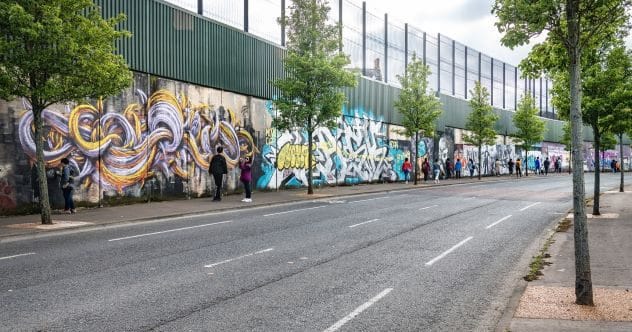For decades, Northern Ireland was engulfed in a period of intense conflict known as The Troubles. Stretching roughly from the late 1960s to the late 1990s, this era saw violence spill over into the Republic of Ireland and England. At its heart, the conflict stemmed from deep-seated political and sectarian divisions, primarily between the majority Protestant community, who largely wished to remain part of the United Kingdom, and the significant Catholic minority, who often sought reunification with the Republic of Ireland and faced discrimination.
As civil rights movements gained momentum globally in the 1960s, Catholics in Northern Ireland demanded equal rights and an end to systemic inequality. When dialogue failed and extremism took hold on both sides, the region descended into violence. Here are ten stories that offer a glimpse into the complexities and tragedies of The Troubles.
10. Troubles Brewing: The Roots of the Conflict
Understanding The Troubles requires looking back at modern Irish history. The 1916 Easter Rising, though unsuccessful initially, fueled the desire for Irish independence from British rule. This eventually led to the Government of Ireland Act 1920 and the Anglo-Irish Treaty, partitioning the island.
Twenty-six predominantly Catholic counties formed the Irish Free State (later the Republic of Ireland), while six northeastern counties with Protestant majorities remained part of the UK, creating Northern Ireland. This Protestant majority largely stemmed from the Plantation of Ulster in the 17th century, when English and Scottish settlers were encouraged to move there.
From the outset, Northern Ireland had a substantial Catholic minority often favouring a united Ireland. The conflict, often framed as ‘Catholics vs. Protestants’, was fundamentally about national identity and political power: Irish nationalism versus British unionism. Allegations of discrimination and suppression against the Catholic community simmered for decades before boiling over in the late 1960s. The 1998 Good Friday Agreement largely brought the violence to an end, but Northern Ireland remains part of the UK, a reality that continues to shape its politics.
9. The First to Die
While 1969 marks the widely recognized start of The Troubles’ intense phase, the first recorded killing attributed to the conflict occurred three years earlier. On May 27, 1966, John Scullion, a 28-year-old Catholic man, was shot near his home in Belfast.
His attackers were members of the Ulster Volunteer Force (UVF), a loyalist paramilitary group dedicated to maintaining Northern Ireland’s union with Great Britain. Scullion passed away from his injuries two weeks later. Controversy surrounded the investigation, with the Royal Ulster Constabulary (RUC), Northern Ireland’s police force, initially claiming Scullion was stabbed, leading to accusations of a cover-up. His body was even exhumed to verify the gunshot wound.
It later emerged that Gusty Spence, a UVF leader, was the gunman. He shot Scullion as he walked home from a pub. The UVF killed two more people shortly after: Peter Ward, another Catholic man, and Matilda Gould, a Protestant woman killed accidentally. Spence eventually served 18 years for Ward’s murder. Scullion’s headstone simply reads: “Murdered for his faith.” His death tragically foreshadowed the more than 3,500 lives lost over the next three decades.
8. Among the First Victims Was a Nine-Year-Old Boy
In August 1969, tensions flared in Belfast. Catholic protests against discrimination erupted into riots, prompting the deployment of British troops to restore order. This period marked one of the first major escalations of The Troubles.
Loyalist mobs attacked and burned Catholic areas, while members of the Irish Republican Army (IRA) engaged in resistance. Amidst the chaos in the Divis Flats area, resident Neely Rooney stepped outside to assess the situation as a nearby pub burned. British soldiers attempted to disperse crowds by firing machine guns, supposedly over their heads.
However, bullets struck the Divis Flats building. Con Neely, one of Rooney’s sons, recounted how bullets ripped through their home. His mother, Alice, was grazed, and Neely himself was shot but survived. Tragically, their nine-year-old son, Patrick, was also hit. Alice recalled him slumping against the wall; she thought he’d fainted until she saw the blood. Patrick Rooney died shortly after, becoming one of the conflict’s earliest child victims. No one was ever prosecuted for his death.
7. Safety in Numbers: Belfast’s Self-Segregation
As sectarian violence intensified, living side-by-side became untenable for many Catholics and Protestants. Fear drove a process of self-segregation, particularly in urban areas like Belfast. Catholics moved out of predominantly Protestant areas into Catholic enclaves, and Protestants did the reverse.
This created sharply divided neighbourhoods where community affiliation was easily identified by address alone. Suddenly, asking someone “where you from?” could be a loaded and dangerous question. To manage the escalating violence, the British government began constructing physical barriers between these communities in late 1969.
These structures, often called ‘Peace Walls’ or ‘Peace Lines’, featured gates that were locked each night and reopened in the morning, enforcing separation as a means of coexistence. The most famous walls still stand today, some stretching for miles and covered in political murals and messages from visitors. Despite the Good Friday Agreement in 1998, distrust lingers. A 2013 pledge to remove all walls by 2023 has not been met, with over 100 barriers remaining, stark reminders of the deep divisions etched into the city’s landscape.
6. Sunday, Bloody Sunday
January 30, 1972, is a date seared into the memory of Northern Ireland. In the city officially named Londonderry (but called Derry by nationalists), the Northern Ireland Civil Rights Association organized a march protesting interment without trial. British paratroopers opened fire on the unarmed demonstrators.
Fourteen people were killed (one died later from injuries), and fifteen others were wounded. The event, immortalized in U2’s song, became known as Bloody Sunday and marked a devastating turning point in The Troubles. Many saw it as the moment the conflict became irreconcilable.
The immediate aftermath was explosive. Nationalist politicians condemned the killings, tensions flared, and the British embassy in Dublin was firebombed. Crucially, Bloody Sunday massively swelled the ranks of the IRA, as enraged young nationalists sought revenge. The British government’s initial inquiry largely exonerated the soldiers, further deepening the bitterness. Violence escalated dramatically: while around 200 lives were lost in the three years prior, 1972 saw 479 killings, the deadliest year of the entire conflict.
5. The Deadliest Day, and Other Lowlights
Violence reached horrific peaks during The Troubles. May 17, 1974, stands as the conflict’s single deadliest day. Coordinated car bombs planted by the UVF exploded during evening rush hour in Dublin and later in the border town of Monaghan, both in the Republic of Ireland. Thirty-three civilians and one unborn child were killed, and around 300 people were injured.
The Provisional IRA (PIRA) also orchestrated devastating attacks. On July 21, 1972, known as Bloody Friday, they detonated 22 bombs across Belfast within 75 minutes, killing nine people (including two soldiers) and injuring many more. In March 1973, the PIRA extended its campaign to England, setting off car bombs in London that injured over 200 people, though miraculously only one person died from a heart attack.
Even after the 1998 Good Friday Agreement aimed to end the violence, splinter groups continued attacks. In August 1998, the ‘Real IRA’ bombed Omagh, Northern Ireland, killing 29 civilians, including a woman pregnant with twins, and injuring hundreds. This attack, coming after the peace accord, was particularly shocking and widely condemned.
4. Doctors of Doom: Assassinated in a Hospital
Máire Drumm was a prominent figure in republican politics, serving as Vice President of Sinn Féin, the political party associated with the IRA. Known for her fiery rhetoric and activism, she played a visible role in events like the Falls Curfew in 1970, where she helped deliver supplies to besieged residents.
Her activism, however, often crossed legal lines in the eyes of the authorities. She was jailed multiple times for speeches deemed seditious, including one where she allegedly encouraged people to join the IRA and another where she threatened to destroy Belfast “stone by stone.”
In October 1976, while recovering from eye surgery in Belfast’s Mater Hospital, the 57-year-old Drumm was assassinated. Two members of the loyalist Red Hand Commando, disguised as doctors, entered her hospital room and shot her dead. At the time, rumours circulated that her ill health might lead her to step down from Sinn Féin and move south. Her murder in a hospital bed sent shockwaves through the nationalist community, with many suspecting collusion or negligence by security forces.
3. Power Hungry: The Prison Strike That Spurred IRA Recruitment
Bobby Sands became one of the most iconic figures of The Troubles, galvanizing republican support through his actions in prison. Sentenced in 1976 for firearms possession after a bombing, Sands became involved in protests against the British government’s removal of Special Category Status for paramilitary prisoners.
This status had afforded them certain privileges akin to prisoners of war. Its removal meant they were treated as common criminals, leading to protests like refusing to wear prison uniforms (the ‘blanket protest’) and later refusing to wash or clean their cells (the ‘dirty protest’). Sands, a leader among the prisoners in the Maze Prison (also known as Long Kesh), began refusing food on March 1, 1981.
His hunger strike aimed to force the government to concede on five demands, including the right to wear their own clothes and exemption from prison work. During the strike, Sands was famously elected as a Member of Parliament for Fermanagh and South Tyrone. He died after 66 days without food on May 5, 1981. Nine other republican prisoners also died during the hunger strike. Sands’ death provoked widespread rioting and international condemnation, significantly boosting IRA recruitment and support for Sinn Féin.
2. The Hateful ’80s
The 1980s witnessed some of the most brutal violence of The Troubles, with republican paramilitary groups often taking the lead in attacks, many of which appeared indiscriminate and claimed numerous civilian lives.
While attacks on military targets continued, such as the PIRA’s 1982 bombings in London’s Hyde Park and Regent’s Park which killed 11 soldiers, civilian casualties mounted. In August 1982, an Irish National Liberation Army (INLA) bomb killed a British soldier but also two children in Divis Flats. The following year, INLA gunmen attacked a Protestant church service, killing three worshippers. Also in 1983, a PIRA bomb outside Harrod’s department store in London killed six people and injured 90 during the busy Christmas shopping period.
In 1984, the PIRA targeted the British political establishment, bombing the Grand Hotel in Brighton during the Conservative Party conference, killing five people, including an MP, in an attempt to assassinate Prime Minister Margaret Thatcher. The Enniskillen bombing on Remembrance Day 1987, where a PIRA bomb killed 11 civilians and one police officer gathered for a memorial service, caused widespread revulsion. These acts, often targeting civilians, damaged the republican cause internationally while deepening sectarian hatred.
1. A Troubling Truth: Northern Ireland Today
Moving beyond the painful legacy of The Troubles is a slow and ongoing process for Northern Ireland. Many believe true reconciliation requires the passage of time, allowing a generation that grew up largely in peacetime to lead the way, less encumbered by the direct trauma and intractable positions of the past.
However, even young adults today carry scars. Some recall witnessing horrific violence long after the 1998 Good Friday Agreement was signed. The segregation institutionalized during the conflict persists; even now, fewer than 10% of Northern Irish students attend religiously integrated schools. Initiatives like the “Are You ‘In’?” campaign are pushing for more integration, but progress is slow.
For many older residents, particularly those living near the Peace Walls like 70-year-old Frank Brennan from Belfast’s Short Strand, the physical and psychological barriers remain necessary for a sense of security. Brennan, who served time for republican activities, admits feeling safer with the walls up. This sentiment highlights the enduring challenge: while large-scale violence has ceased, the deep-seated divisions and mistrust forged during The Troubles continue to shape Northern Ireland’s present and future.
Conclusion
The Troubles represent a complex and tragic chapter in Irish and British history, marked by profound loss, political deadlock, and enduring sectarian divides. These ten stories offer only a snapshot of the decades of conflict, highlighting the human cost, the key turning points, and the long shadow the era continues to cast over Northern Ireland today. While peace has largely held since 1998, the journey toward true reconciliation and a fully integrated society remains ongoing.
What are your thoughts on these events? Share your perspective in the comments below.










